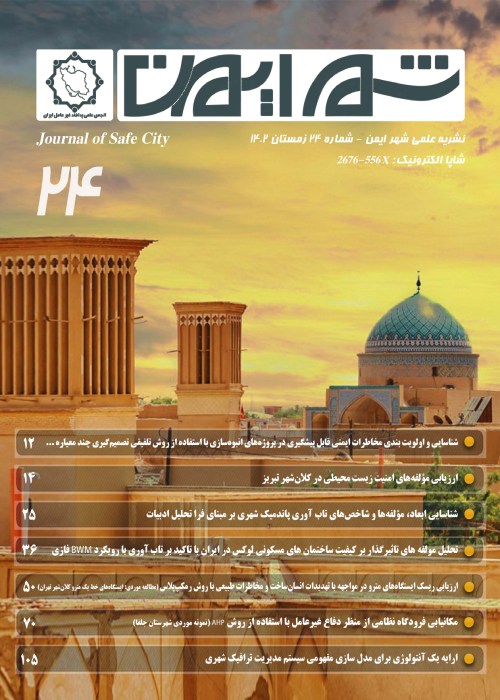Vulnerability assessment of cities with passive defense approach using IHWP method & GIS (case study: Tehran)
When war or crisis occurs in the cities, damages in various forms take place within a short period of time due to the instability of the civil elements and spaces. Nowadays, the rate of vulnerability of cities is estimated more than before because of such reasons as unobserved hierarchy of communication networks, narrowness of ways, the cities’ distance from the health service centers, and dense texture of the cities. Hence, the civil defense has been identified as one of the most effective ways of defense against the threats which reduces the amount of vulnerabilities against the threats. Tehran is the largest city in Iran with being considerably distinguished from other cities. It is also identified as the center of the country’s economy, population and culture in addition to being the origin of the greatest social, religious, and national activities together with a centralized system in which all decisions are made. The present research is an applied and developmental one which aims to extract the human-made threats, and to evaluate the existing damages in the city of Tehran. Over the research, documentation, library, and questionnaire (quantitative) methods were applied to collect data. The methodology in this research is analytical and evaluative (content analysis). To analyze the vulnerability, the IHWP logic was used, moreover, to process the data, the GIS software, and to extract the basic human-made threats of the large city of Tehran, the AHP method were respectively applied. In this research, the rate of the city’s vulnerability was modeled in the GIS environment by using such sixteen indexes as access to the health centers, the width of the street, distance from the military centers, and distance from the worn-out textures, population density, access to the fire-fighting centers, and the average of parts’ area. The results of the research showed that the air aggression could be the basic threat to the large city of Tehran in such a way that 29/83 percent of the city’s parts is of very low vulnerability to the air aggression, 24/54 percent has low vulnerability, 42/86 percent has a medium range of vulnerability, 15/96 percent is of high vulnerability, and 8/97 percent of the city parts is of a very high vulnerability to the mentioned air aggression. However, the both the north-eastern and north-western parts of Tehran are of higher vulnerability in comparison to other parts of the city, knowing that the vulnerability decreases from the north to the southwards of the city. At last, some suggestions were made with respect to the obtained results.
- حق عضویت دریافتی صرف حمایت از نشریات عضو و نگهداری، تکمیل و توسعه مگیران میشود.
- پرداخت حق اشتراک و دانلود مقالات اجازه بازنشر آن در سایر رسانههای چاپی و دیجیتال را به کاربر نمیدهد.



